
Introduction
Jyotirlingas and Their Significance in Hinduism
In the vast and rich tapestry of Hindu spirituality, the Jyotirlingas hold a place of immense reverence and importance. The term “Jyotirlinga” is derived from two Sanskrit words: “Jyoti,” meaning light, and “Linga,” which represents the iconic symbol of Lord Shiva. Together, Jyotirlinga translates to “the radiant sign of Shiva.” These sacred shrines are believed to be the manifestations of Lord Shiva himself, appearing as columns of pure light. The Jyotirlingas are not merely religious symbols; they embody the essence of divine light and spiritual enlightenment in Hindu philosophy.
According to ancient Hindu scriptures, there are twelve Jyotirlingas scattered across India. Each of these shrines is unique, with its own set of legends and historical significance. The devotion towards Jyotirlingas is deeply rooted in the stories of Shiva’s miraculous appearances and blessings bestowed upon his devotees. Pilgrims from across the globe undertake arduous journeys to these holy sites, seeking spiritual solace, divine intervention, and the ultimate liberation from the cycle of birth and rebirth.
Overview of Jyotirlingas
The twelve Jyotirlingas are sacred shrines dedicated to Lord Shiva, strategically located across India, each representing a significant spiritual and geographical point.
Somnath in Gujarat is revered as the first Jyotirlinga, famous for its historical significance and the legend of the moon god, Soma. Mallikarjuna in Andhra Pradesh, situated in the Srisailam hills, symbolizes the union of Shiva and Parvati and is also a Shakti Peetha. Mahakaleshwar in Ujjain, Madhya Pradesh, is known for its unique Bhasma Aarti, while Omkareshwar, located on an island in the Narmada River, represents the sacred Om symbol.
Kedarnath in the Himalayas is a challenging pilgrimage site believed to lead to moksha. Other notable Jyotirlingas include Bhimashankar in Maharashtra, Kashi Vishwanath in Varanasi, and Ramanathaswamy in Tamil Nadu, each with its own unique legends and spiritual significance. Together, these Jyotirlingas form a vital part of Hindu pilgrimage and devotion.
Importance of Jyotirlingas in the Worship of Lord Shiva
The Jyotirlingas are not just temples; they are epicenters of spiritual energy and devotion. Each Jyotirlinga is a gateway to understanding the divine nature of Lord Shiva, who is both the destroyer and the transformer within the Hindu trinity. Worshipping at these sacred sites is believed to cleanse one’s karma, remove sins, and provide a path to moksha. The rituals performed, such as abhishekam (ceremonial bathing of the linga), are deeply symbolic, representing the purification of the soul and the removal of worldly impurities.
The pilgrimage to Jyotirlingas is considered a highly auspicious endeavor. It is said that visiting all twelve Jyotirlingas during one’s lifetime bestows immense spiritual merit and divine blessings. The spiritual journey encompasses not just physical travel but also an inner voyage towards self-realization and enlightenment. Each Jyotirlinga offers a unique experience, reflecting different aspects of Lord Shiva’s infinite nature, from his fierce and destructive persona to his benevolent and nurturing form.
The Jyotirlingas stand as timeless testaments to the profound faith and devotion that have shaped Hindu spiritual traditions over millennia. They continue to inspire countless devotees, drawing them closer to the divine presence of Lord Shiva and the eternal light of spiritual wisdom.
Understanding Jyotirlingas
Definition and Meaning of Jyotirlingas
The term “Jyotirlinga” is a combination of two Sanskrit words: “Jyoti,” meaning light or radiance, and “Linga,” representing the emblematic symbol of Lord Shiva. Together, Jyotirlinga translates to “the radiant sign of Shiva.” Unlike ordinary lingas, Jyotirlingas are believed to be self-manifested (Swayambhu) and represent the infinite nature of Shiva. They are not carved or installed by human hands but are considered divine manifestations that emerged from the cosmic light of Shiva.
Each Jyotirlinga is a beacon of spiritual light, symbolizing the supreme, formless reality from which all creation emanates and into which it ultimately dissolves. These sacred sites are revered as powerful centers of divine energy, where the boundary between the physical and spiritual worlds becomes thin, allowing devotees to experience profound spiritual transformation.
Historical and Mythological Background
The origins of Jyotirlingas are deeply rooted in Hindu mythology and ancient scriptures such as the Shiva Purana and the Linga Purana. According to these texts, there was once a fierce debate between Lord Brahma, the creator, and Lord Vishnu, the preserver, over who was supreme. To settle the dispute, Lord Shiva appeared as a colossal pillar of light, the Jyotirlinga, and challenged both Brahma and Vishnu to find its beginning and end. Vishnu transformed into a boar and delved underground, while Brahma assumed the form of a swan and flew upside down. Despite their efforts, neither could find the limits of the pillar, thus demonstrating Shiva’s infinite and supreme nature.
The twelve Jyotirlingas are believed to have emerged from this pillar of light, each marking a place where Shiva appeared as a radiant column of divine energy. These sites have been revered since ancient times, attracting sages, saints, and devotees who sought Shiva’s blessings and spiritual enlightenment.
The Spiritual Significance of Jyotirlingas in Hindu Worship
The Jyotirlingas hold immense spiritual significance in Hindu worship, serving as focal points for devotion and meditation. They represent the formless aspect of Shiva, who transcends all physical attributes and is beyond human comprehension. Worshipping at a Jyotirlinga is believed to purify the soul, cleanse past karmas, and bestow spiritual liberation (moksha).
- Symbol of Divine Light: Jyotirlingas are seen as sources of divine light and wisdom. The radiance of the Jyotirlinga is thought to illuminate the path of righteousness (dharma) and guide devotees towards spiritual awakening. The light signifies the eternal truth that dispels the darkness of ignorance and suffering.
- Centers of Spiritual Energy: Each Jyotirlinga is considered a potent center of spiritual energy (Shakti). The vibrations at these sites are believed to be exceptionally strong, providing a conducive environment for meditation, prayer, and spiritual practices. Devotees often report experiencing a heightened sense of peace, clarity, and connection to the divine.
- Manifestations of Shiva’s Infinite Nature: The Jyotirlingas are direct manifestations of Shiva’s boundless and formless nature. They symbolize his ability to transcend physical limitations and exist beyond time and space. This understanding reinforces the belief in Shiva as the ultimate reality, encompassing creation, preservation, and destruction.
- Path to Moksha: Visiting and worshipping at the Jyotirlingas is said to be a path to moksha, or liberation from the cycle of birth and death. The pilgrimages to these sacred sites are seen as acts of immense piety and devotion, capable of dissolving sins and liberating the soul from worldly attachments.
- Cultural and Community Significance: Jyotirlingas also play a vital role in the cultural and social life of Hindu communities. The festivals and rituals associated with these temples bring people together, fostering a sense of unity and shared spirituality. They serve as living traditions, preserving ancient practices and beliefs across generations.
In essence, the Jyotirlingas embody the quintessence of Lord Shiva’s divine presence. They are not merely physical structures but powerful symbols of the eternal, infinite light that pervades the universe. Through their deep historical roots, mythological significance, and profound spiritual impact, the Jyotirlingas continue to inspire and guide millions of devotees on their journey towards self-realization and ultimate union with the divine.
The 12 Jyotirlingas of India
Somnath Jyotirlinga, Gujarat
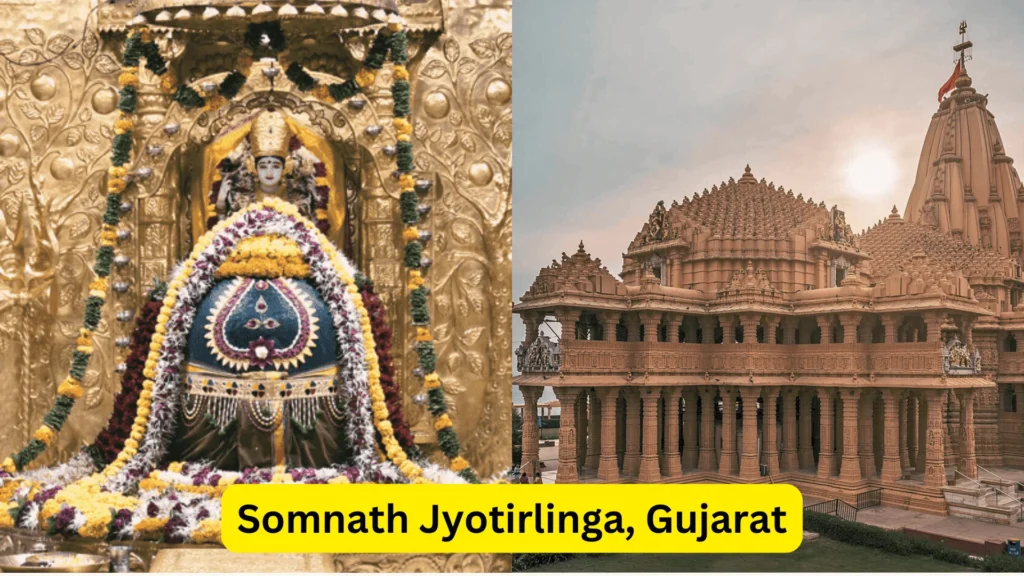
Somnath Jyotirlinga, located in Prabhas Patan near Veraval in Saurashtra, Gujarat, is considered the first among the twelve Jyotirlingas. The temple has a rich history and is steeped in legends. According to mythology, the Moon God, Soma, was cursed by his father-in-law, Daksha, to wane. Soma then prayed to Lord Shiva at this site, who relieved him of the curse, leading to the waxing and waning phases of the moon. This legend underscores the name “Somnath,” meaning “Lord of the Moon.”
The Somnath temple has faced numerous invasions and reconstructions over centuries. It was destroyed and rebuilt several times, with the first documented instance being by Mahmud of Ghazni in 1024 CE. The current structure, a magnificent example of Chalukya architecture, was completed in 1951 through the efforts of Sardar Vallabhbhai Patel and K.M. Munshi.
The Somnath temple is renowned for its stunning architecture, featuring intricate carvings and a grand shikhara (spire) rising 155 feet high. The temple’s main sanctum houses the Jyotirlinga, a symbol of Shiva’s eternal light. Key attractions include the Sabha Mandap (assembly hall), which showcases exquisite pillars and ceilings, and the Nandi Mandap, which houses a large statue of Nandi, Shiva’s bull. The temple complex also includes a beautiful sea-facing promenade, offering breathtaking views of the Arabian Sea, particularly at sunset.
Mallikarjuna Jyotirlinga, Andhra Pradesh
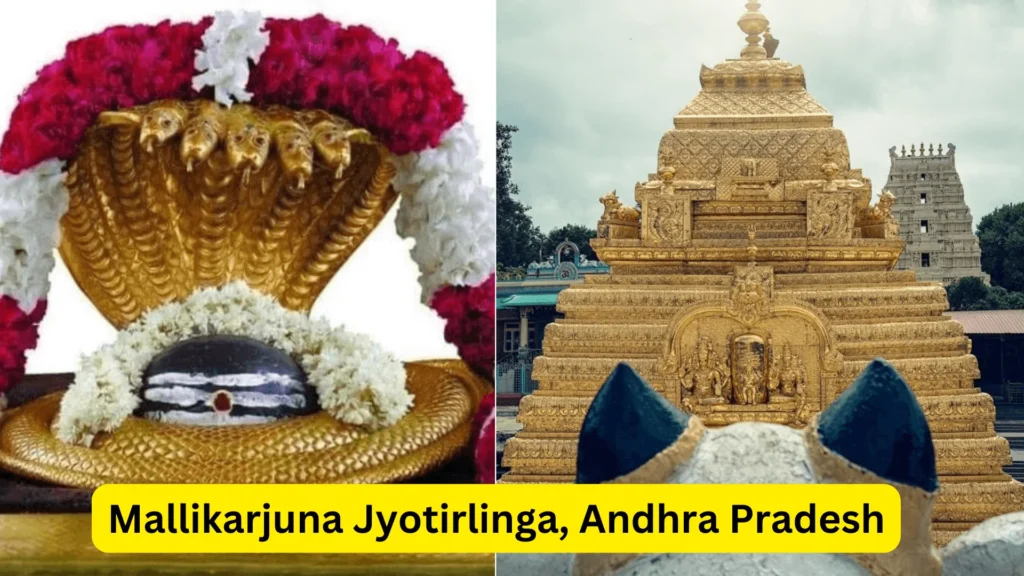
Mallikarjuna Jyotirlinga is situated in Srisailam, Andhra Pradesh, atop the Nallamala hills. It is unique as it is also one of the 18 Shakti Peethas, where the divine feminine energy, Shakti, is worshipped alongside Shiva. According to legend, Shiva and Parvati took the form of Mallikarjuna and Bhramaramba to bless their devotees. The temple is associated with the story of Lord Kartikeya, who, after losing a race to his brother Ganesha, retreated to the hills of Srisailam. Shiva and Parvati followed him to console him, and thus, the temple came into existence.
Mallikarjuna Jyotirlinga is renowned for its elaborate rituals and festivals. Maha Shivaratri is the most significant festival that attracts thousands of devotees. Other important celebrations include Karthika Masam and Ugadi, the Telugu New Year. Daily rituals include multiple aartis, abhishekam (ceremonial bathing of the linga), and the chanting of Vedic hymns. The temple’s unique feature is the Patala Ganga, a sacred river believed to have purifying properties.
Mahakaleshwar Jyotirlinga, Madhya Pradesh
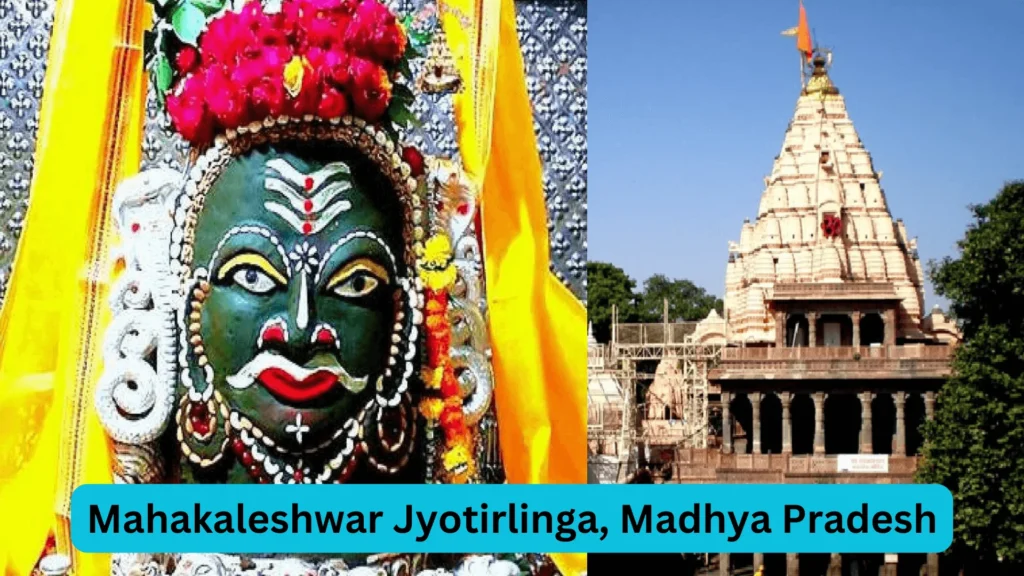
Mahakaleshwar Jyotirlinga, located in Ujjain, Madhya Pradesh, is one of the most revered temples in India. It is the only Jyotirlinga where the deity faces south, earning it the name “Dakshinamukhi.” The temple is renowned for its Bhasma Aarti, a special ceremony in which the linga is worshipped each morning with holy ash.
Mahakaleshwar is deeply embedded in the cultural and religious fabric of Ujjain. The temple is a vital center for Shaivism, and its rituals and festivals draw devotees from across the country. Maha Shivaratri is celebrated with grandeur, marked by day-long prayers, processions, and cultural performances.
Smaller shrines honoring different deities can be found within the temple complex, and the neighborhood is full of spiritual and historical landmarks, including the Ram Ghat on the Kshipra River, the location of the Kumbh Mela that takes place once in twelve years.
Omkareshwar Jyotirlinga, Madhya Pradesh

Omkareshwar Jyotirlinga is located on Mandhata Island in the Narmada River in Madhya Pradesh. The island is shaped like the sacred Hindu symbol ‘Om,’ making it a significant pilgrimage site. The temple is one of the two Jyotirlingas in Madhya Pradesh, the other being Mahakaleshwar.
The Omkareshwar temple features a blend of North and South Indian architectural styles. The main shrine houses the Jyotirlinga, which is worshipped with great devotion. The temple complex includes several smaller shrines and the Mamleshwar temple, which is equally important.
Visitors can reach Omkareshwar by boat or on foot via a bridge. The temple’s serene location on the island, amidst the Narmada’s flowing waters, adds to its spiritual ambiance. Pilgrims often participate in parikrama (circumambulation) of the island, believed to bring spiritual merit.
Kedarnath Jyotirlinga, Uttarakhand
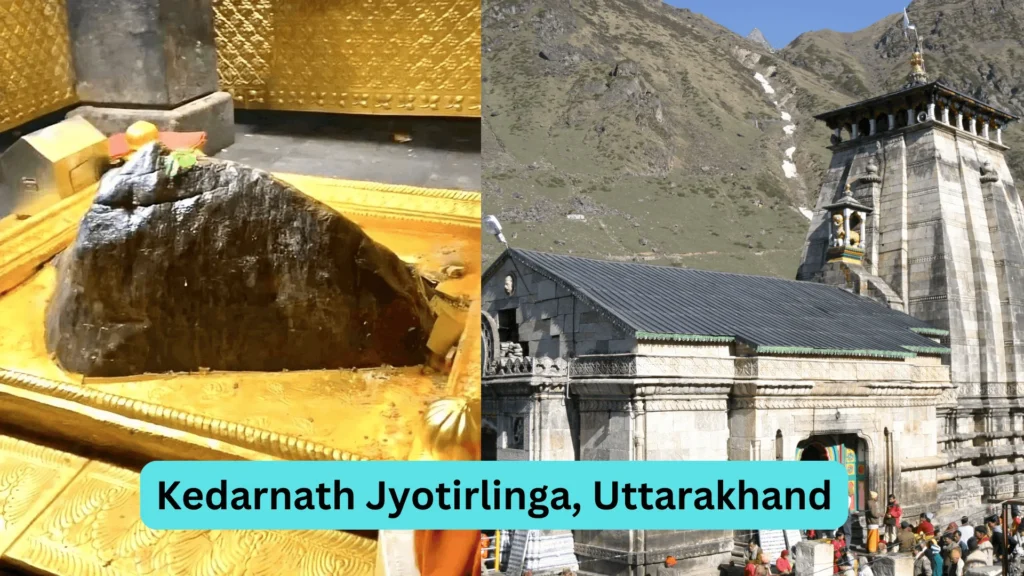
Kedarnath Jyotirlinga, situated in the Himalayas of Uttarakhand, is one of the most remote and revered of the twelve Jyotirlingas. According to mythology, after the Kurukshetra War, the Pandavas sought Shiva’s blessings to atone for their sins. Shiva evaded them by taking the form of a bull and diving into the ground. When the Pandavas caught him, he reappeared in parts, with his hump at Kedarnath, making it a sacred site.
Reaching Kedarnath requires a challenging trek of about 16 kilometers from Gaurikund, although helicopter services are available for those unable to undertake the journey. The temple is open only from April to November due to harsh winter conditions.
Pilgrims are advised to be well-prepared for the trek, with adequate warm clothing, sturdy footwear, and essential supplies. The temple’s high-altitude location offers breathtaking views of the surrounding peaks, adding to the spiritual experience.
Bhimashankar Jyotirlinga, Maharashtra
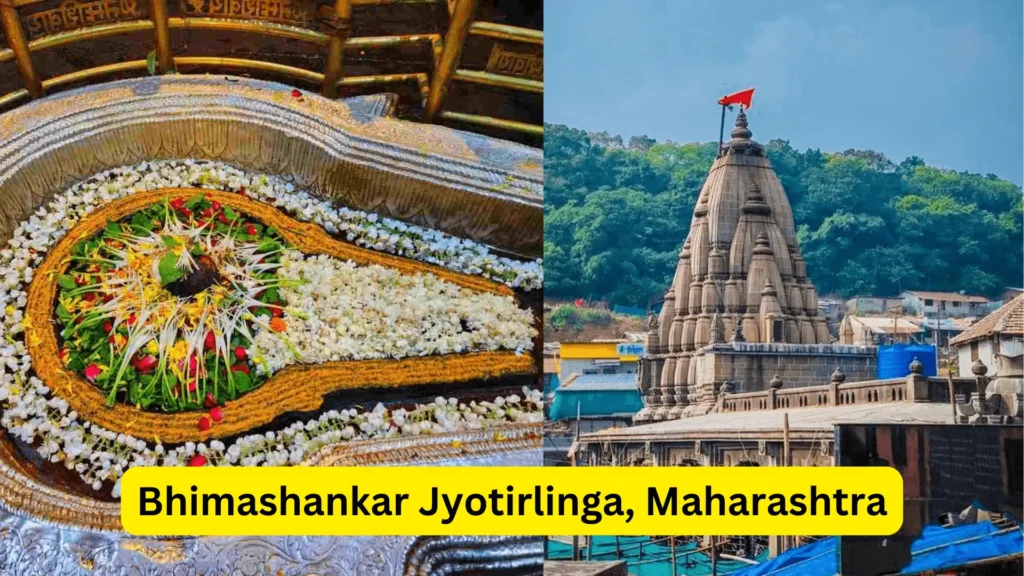
Bhimashankar Jyotirlinga is located in the Sahyadri ranges of Maharashtra, amidst dense forests and picturesque landscapes. The temple is associated with the legend of Lord Shiva’s battle with the demon Tripurasura. After vanquishing the demon, Shiva is said to have rested at this site, and his sweat formed the Bhima River.
Bhimashankar is not only a spiritual destination but also a haven for nature enthusiasts. The temple is surrounded by the Bhimashankar Wildlife Sanctuary, home to diverse flora and fauna, including the Indian giant squirrel. The temple itself is a blend of old and new structures, with intricate carvings and sculptures. The natural beauty of the region, coupled with the spiritual significance of the Jyotirlinga, makes Bhimashankar a unique and enriching pilgrimage site.
Kashi Vishwanath Jyotirlinga, Uttar Pradesh
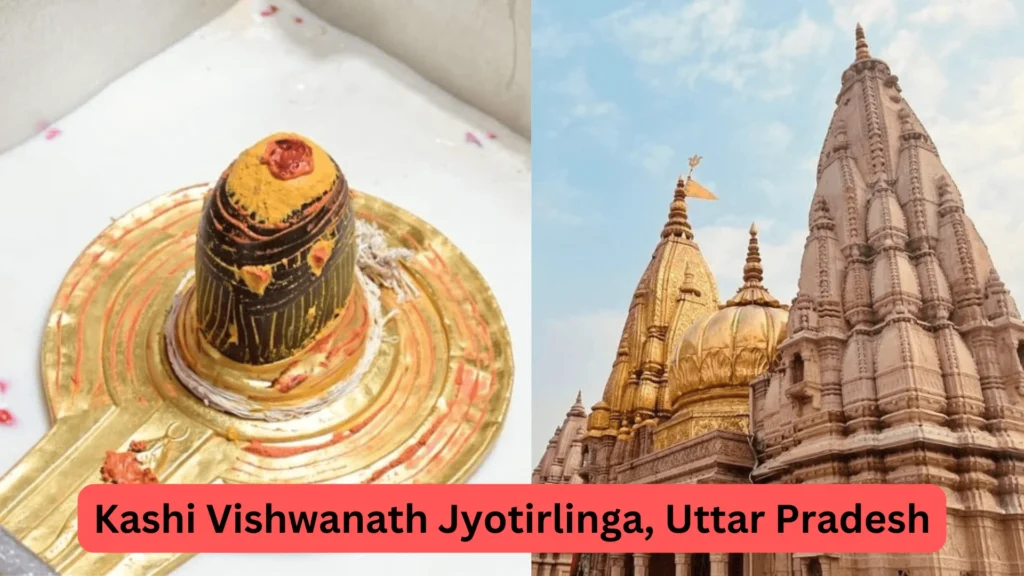
Hinduism places great importance on Kashi, also called Varanasi, which is among the world’s oldest continuously inhabited cities. It is often referred to as the spiritual capital of India. Kashi Vishwanath Jyotirlinga, located in Varanasi, is dedicated to Lord Shiva, who is believed to be the city’s guardian. According to Hindu belief, a visit to Kashi Vishwanath and a dip in the sacred Ganges River can cleanse one of all sins and lead to moksha (liberation). The city is mentioned in various scriptures, including the Rigveda, and is considered a microcosm of Hindu tradition and culture.
The Kashi Vishwanath temple is renowned for its elaborate daily rituals. The main rituals include Mangala Aarti (pre-dawn worship), Bhog Aarti (afternoon worship), and Shringar Aarti (evening worship). The temple also conducts special rituals during significant Hindu festivals like Maha Shivaratri, Kartik Purnima, and Diwali.
Visitors should note that the temple is located in a densely populated area, and security is stringent. It is advisable to visit during early morning hours to avoid long queues. The temple complex also includes the Annapurna Devi temple, where devotees often pay their respects. The Gyanvapi Well, believed to have holy water from the Ganges, is another significant site within the temple premises.
Trimbakeshwar Jyotirlinga, Maharashtra
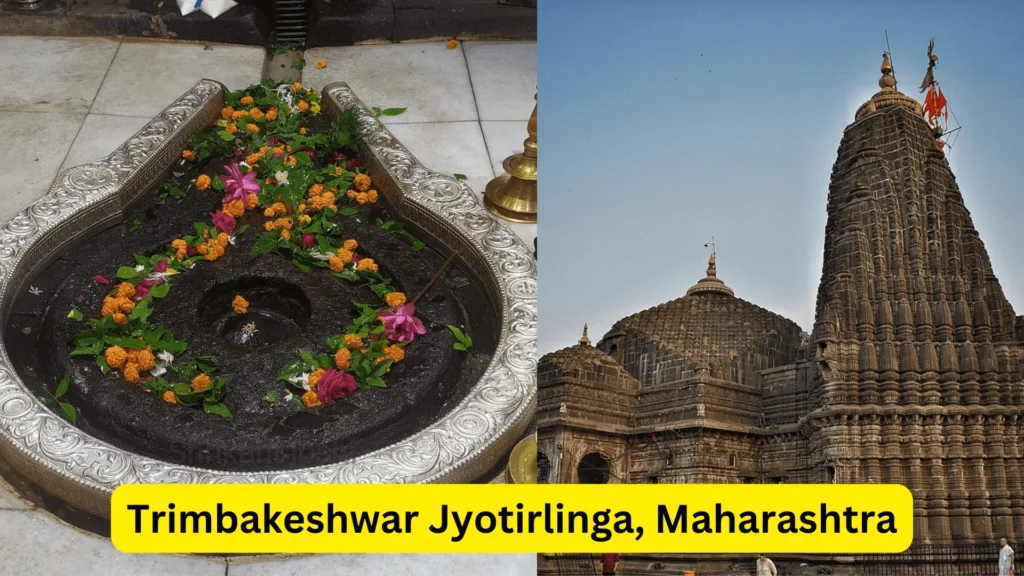
Trimbakeshwar Jyotirlinga is located in the town of Trimbak, near Nashik, Maharashtra. The temple is situated at the source of the Godavari River, which is considered one of the holiest rivers in India. According to legend, Sage Gautama’s intense penance brought the Ganges down to earth at this location, and Lord Shiva manifested as Trimbakeshwar. The temple is unique because the linga here has three faces, representing Brahma, Vishnu, and Shiva, making it a significant site for the worship of the Trimurti.
Trimbakeshwar is the focal point of many important Hindu festivals. The most notable is Maha Shivaratri, which draws thousands of devotees who participate in night-long vigils and special rituals. Another major festival is Kumbh Mela, which occurs once every twelve years in Nashik. During this period, devotees gather in massive numbers for a holy dip in the Godavari River, seeking spiritual cleansing and blessings.
Regular rituals include Rudrabhishek, where the linga is bathed with water, milk, and honey, accompanied by the chanting of Vedic hymns. The temple also offers various other abhishekams and poojas that devotees can participate in.
Vaidyanath Jyotirlinga, Jharkhand

Vaidyanath Jyotirlinga, also known as Baidyanath, is located in Deoghar, Jharkhand. According to mythology, the demon king Ravana worshipped Shiva with intense devotion at this site to gain invincibility and immense power. Impressed by his penance, Shiva appeared as Vaidyanath (the celestial physician) to heal Ravana’s injuries. This association with healing gives the temple its name and significance.
The Vaidyanath temple complex is known for its simplicity and spiritual ambiance. The main shrine houses the Jyotirlinga, which is believed to have potent healing powers. Devotees offer bilva leaves, flowers, and water to the linga and participate in various poojas and abhishekams.
For visitors, the best time to visit is during the Shravan month (July-August) when the temple hosts the annual Shravani Mela. This month-long festival attracts millions of devotees who undertake a pilgrimage by carrying holy water from the Ganges at Sultanganj, walking over 100 kilometers to Deoghar. It is advisable to book accommodations in advance during this period due to the high influx of pilgrims.
Nageshwar Jyotirlinga, Gujarat
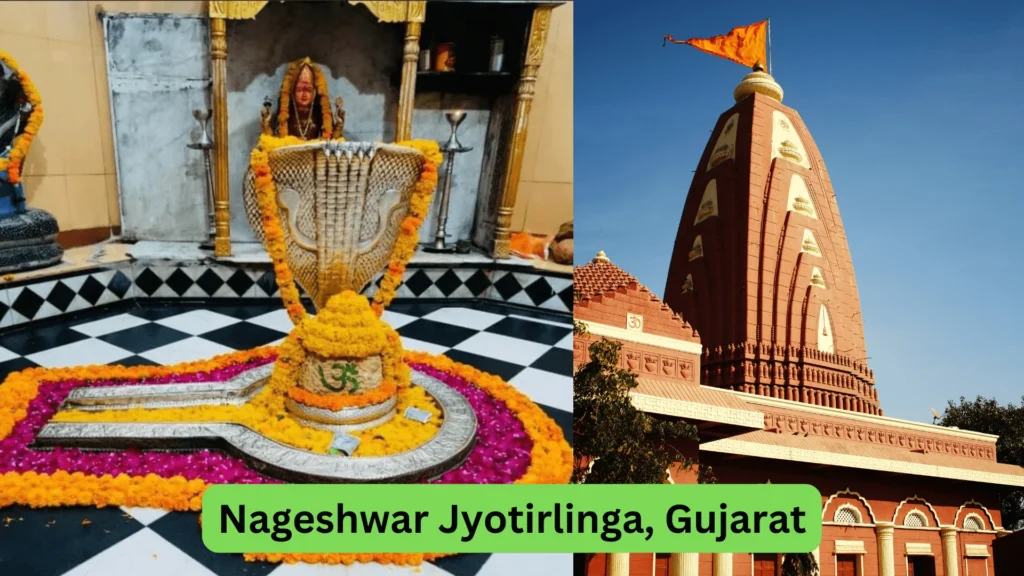
Nageshwar Jyotirlinga, located near Dwarka in Gujarat, is associated with several legends. One popular tale is about a devotee named Supriya who was attacked by a demon named Daruka. Supriya invoked Shiva, who appeared and defeated the demon, establishing himself as Nageshwar (Lord of Serpents). This story highlights the protective aspect of Shiva, who saves his devotees from evil forces.
The Nageshwar temple features a simple yet captivating architectural style. The main sanctum houses the Jyotirlinga, which is believed to face south. A large statue of Lord Shiva, standing 25 meters tall, is a major attraction in the temple complex and can be seen from a distance.
Visitors can reach Nageshwar easily from Dwarka, which is well-connected by road and rail. The temple is open throughout the year, but the best time to visit is during Maha Shivaratri, when the temple is adorned with lights and flowers, and special rituals are conducted.
Ramanathaswamy Jyotirlinga, Tamil Nadu
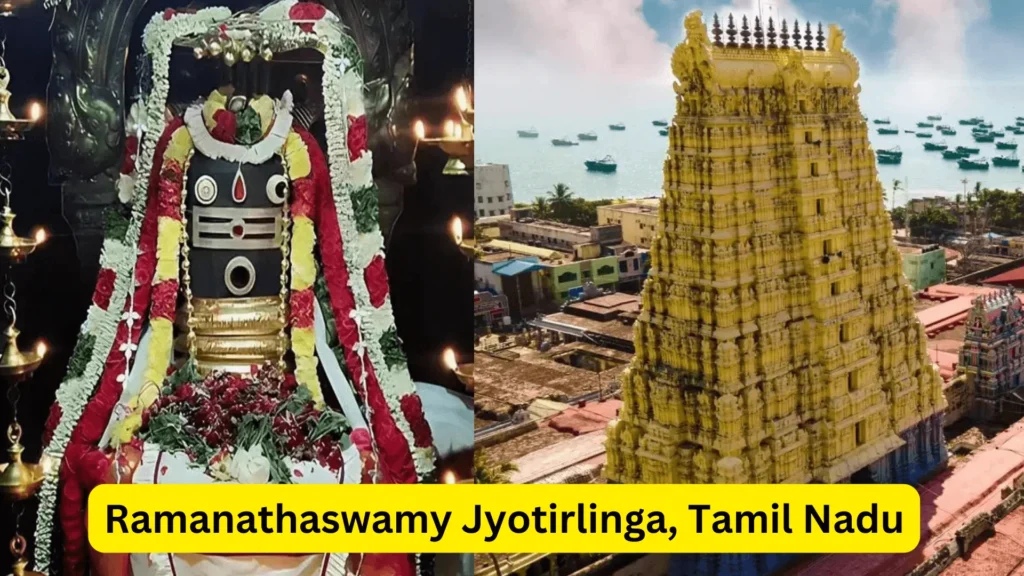
Ramanathaswamy Jyotirlinga is located on Rameswaram island in Tamil Nadu. The temple is closely linked with the epic Ramayana. It is believed that Lord Rama worshipped Shiva here to absolve the sins committed during his war against Ravana. Rama, with the help of Hanuman, installed a linga at this site, which became the revered Jyotirlinga.
The Ramanathaswamy temple is an architectural marvel, renowned for its long corridors, intricate carvings, and majestic towers. The temple’s corridor is the longest of any Hindu temple in India, measuring around 1,200 meters. The main sanctum houses the Jyotirlinga, which is worshipped with great devotion.
Pilgrims often begin their visit with a dip in the Agni Theertham, a sacred stretch of sea, followed by a ritual bath in the temple’s 22 theerthams (holy wells). The temple is easily accessible by road, rail, and air, with the nearest airport located in Madurai. The ideal time to visit is during Maha Shivaratri and the Tamil month of Aadi (July-August), when the temple hosts grand celebrations.
Grishneshwar Jyotirlinga, Maharashtra
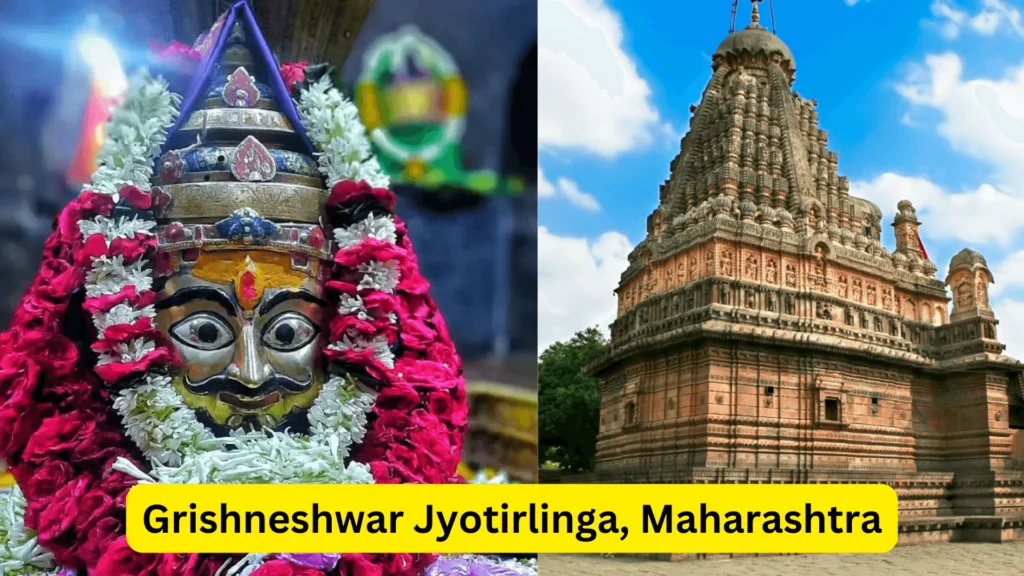
Grishneshwar Jyotirlinga is situated near the Ellora Caves in Maharashtra. According to legend, a devout woman named Kusuma worshipped Shiva with great devotion, immersing a Shivalinga in a tank daily. Her devoutness was challenged, but Shiva manifested himself as the Jyotirlinga, restoring life and peace. This legend highlights the power of devotion and Shiva’s protective nature.
The Grishneshwar temple is a beautiful example of Maratha temple architecture, featuring a five-tier shikhara adorned with intricate carvings. The temple’s sanctum houses the Jyotirlinga, which is worshipped with various rituals, including abhishekam and aartis.
Visitors can reach Grishneshwar easily from Aurangabad, which is well-connected by road, rail, and air. The temple is located close to the famous Ellora Caves, making it a convenient addition to a heritage tour. The best time to visit is during Maha Shivaratri and other major Hindu festivals, when the temple is beautifully decorated, and special rituals are performed.
The Spiritual Journey to Jyotirlingas
Jyotirlingas and Their Significance in Savan
Savan, also known as Shravan, is the fifth month of the Hindu calendar, typically falling in July-August. This period is considered highly auspicious for the worship of Lord Shiva. Devotees believe that during Savan, the cosmic energy of Shiva is more accessible, making it an ideal time for undertaking pilgrimages to Jyotirlingas.
The month of Savan is marked by various rituals, fasts, and special prayers dedicated to Lord Shiva. Visiting Jyotirlingas during this time is believed to amplify the spiritual benefits, as these sacred sites are charged with intense devotional energy. The fervor of the devotees, combined with the monsoon season’s natural beauty, creates an atmosphere of heightened spirituality and devotion.
Practical Tips for Planning a Jyotirlinga Tour
Research and Preparation
- Route Planning: Plan your route in advance. Jyotirlingas are spread across different parts of India, so it’s essential to chart a logical and feasible travel path. Group the Jyotirlingas by their geographical proximity to maximize your time and resources.
- Travel Arrangements: Book your transportation and accommodations well in advance, especially during peak pilgrimage seasons like Savan and Maha Shivaratri. Consider using a mix of air, rail, and road travel for efficiency.
- Health Considerations: Some Jyotirlingas, like Kedarnath, are located in high-altitude areas requiring physical fitness. Prepare accordingly with proper fitness routines, vaccinations, and necessary medications.
Packing Essentials
- Clothing: Carry appropriate clothing, considering the diverse climates—from the tropical heat of Rameswaram to the cold of Kedarnath. Modest and comfortable clothing is recommended for temple visits.
- Footwear: Comfortable, sturdy footwear is essential, especially for treks and long walks. Many temples require visitors to remove their shoes, so carrying a pair of easy-to-remove sandals can be convenient.
- Devotional Items: Bring your personal items for worship, such as rudraksha beads, prayer books, and offerings like flowers and incense. Some temples may also require specific items for rituals, so check in advance.
Cultural and Local Experiences Along the Journey
Engaging with Local Traditions
- Festivals and Fairs: Time your visit to coincide with local festivals. Each Jyotirlinga has its unique celebrations, offering a glimpse into the rich cultural tapestry of India. Participating in these festivals can enhance your spiritual experience and understanding of regional traditions.
- Local Cuisine: Sample the local cuisine at each destination. The prasadam (sacred food offering) at temples is a must-try, often reflecting the regional culinary style. Exploring local markets and eateries can add a delightful gastronomic dimension to your journey.
- Handicrafts and Souvenirs: Support local artisans by purchasing handicrafts and souvenirs. Many temple towns are known for their unique crafts, such as brassware in Varanasi and silk saris in Rameswaram.
Exploring Natural and Historical Sites
- Heritage Sites: Many Jyotirlingas are located near significant historical and archaeological sites. For instance, the Ellora Caves near Grishneshwar and the ancient city of Varanasi near Kashi Vishwanath. Exploring these sites can provide a deeper appreciation of India’s historical and cultural heritage.
- Natural Beauty: Enjoy the natural landscapes surrounding Jyotirlingas. The Sahyadri hills of Bhimashankar, the Narmada River at Omkareshwar, and the serene beaches of Somnath offer stunning backdrops for reflection and meditation.
Conclusion & FAQs
Jyotirlingas are more than just pilgrimage sites; they are the radiant symbols of Lord Shiva’s eternal presence and power. Each Jyotirlinga has its unique history, legends, and spiritual significance, making them central to Hindu worship and devotion. They represent the divine light that dispels ignorance and brings spiritual enlightenment, guiding devotees on their path to self-realization and moksha.
Embarking on a pilgrimage to Jyotirlingas is not just a physical journey but a profound spiritual quest. It offers an opportunity to connect deeply with Lord Shiva, experience the rich cultural heritage of India, and engage in self-reflection and inner growth. Whether you are seeking spiritual solace, historical insights, or a deeper connection to your faith, visiting Jyotirlingas can be a transformative experience.
We invite you to share your own stories and experiences of visiting Jyotirlingas. Your insights and reflections can inspire others on their spiritual journeys and create a community of shared devotion and learning. Please leave your comments, stories, and photographs in the section below, and let’s continue to celebrate the divine light of Jyotirlingas together.
Frequently Asked Questions (FAQs)
What is a Jyotirlinga?
A Jyotirlinga is a sacred symbol for Lord Shiva. The term ‘Jyotirlinga’ means ‘pillar of light,’ and it symbolizes the infinite nature of Shiva. There are twelve Jyotirlingas in India, each with its own unique history and significance.
Why are Jyotirlingas important in Hinduism?
Jyotirlingas are considered highly sacred in Hinduism. They are believed to be places where Shiva appeared as a fiery column of light. Devotees believe that visiting these sites can lead to spiritual liberation and fulfillment of desires.
What is the significance of visiting Jyotirlingas during the month of Savan?
Savan is an auspicious month dedicated to Lord Shiva. Visiting Jyotirlingas during this period is believed to enhance spiritual benefits, as the divine energy of Shiva is considered more accessible.
How should I plan a tour to visit the Jyotirlingas?
Planning a Jyotirlinga tour involves researching routes, booking travel and accommodations in advance, considering health and fitness for treks, and packing essentials like appropriate clothing and devotional items. Grouping Jyotirlingas by geographical proximity can make the tour more efficient.
What are some key rituals performed at Jyotirlinga temples?
Key rituals at Jyotirlinga temples include abhishekam (ceremonial bathing of the linga), aarti (prayer with light), and special poojas. These rituals vary slightly at each temple but generally involve offerings of water, milk, flowers, and chanting of Vedic hymns.
Can you recommend the best time to visit Jyotirlingas?
While Jyotirlingas can be visited year-round, the best times are during Savan (July-August) and Maha Shivaratri, when the temples are adorned with decorations and special rituals are conducted.
What cultural experiences can I expect during a Jyotirlinga pilgrimage?
During a Jyotirlinga pilgrimage, you can participate in local festivals, taste regional cuisines, and explore local handicrafts and markets. Many Jyotirlinga sites are near significant historical and natural attractions, enriching your cultural experience.
Are there any health considerations for visiting Jyotirlingas?
Yes, especially for high-altitude temples like Kedarnath. It is important to be physically prepared, carry necessary medications, and acclimatize properly. Consulting with a doctor before undertaking such a journey is advisable.
What are some important festivals celebrated at Jyotirlinga temples?
Important festivals include Maha Shivaratri, Kumbh Mela, and local festivals unique to each temple, like the Shravani Mela at Vaidyanath Jyotirlinga. These festivals involve elaborate rituals, processions, and large gatherings of devotees.
How can I share my experience of visiting Jyotirlingas?
You can share your experiences by leaving comments and stories on the blog post, posting photographs, and engaging with other readers. Sharing your journey can inspire and guide others planning their own pilgrimages.
